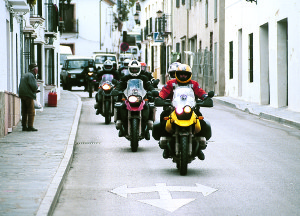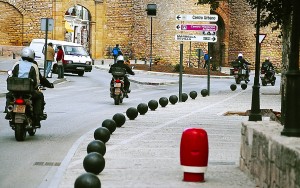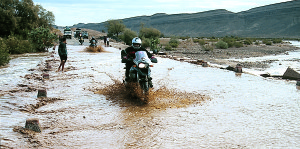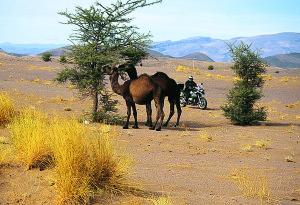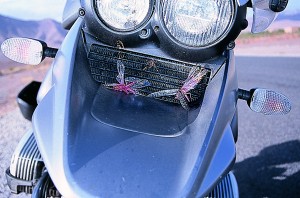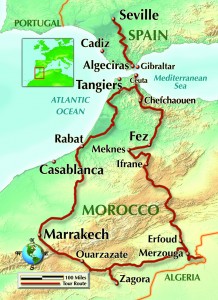Were I to believe everything on the news, I almost certainly never would have ventured into Morocco. And if I had listened to my friend’s jealousy-rooted rants, I may have been convinced that indeed, after 50, great adventures were all behind me. I’m pleased to declare that both sources were wrong.
Scott Moreno, or Ali Baba as he’s referred to in Morocco, is managing director and the driving force behind Iberian Moto Tours. Scott’s in the business of providing world-class motorcycle magic in the form of tours to Morocco, the French Pyrenees, and throughout Spain. There are, in fact, over a dozen tour variations and the number is growing. Born in New York, Scott worked on Wall Street as a stockbroker before being transferred to Spain to trade commodities. While on a motorcycle vacation a friend asked him what would make him truly happy. His answer was, “To ride motorcycles to exotic places and get paid for it,” and so, Iberian Moto Tours was conceived.
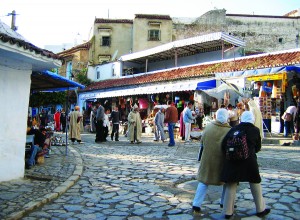
Putting his MBA degree to good practice, Scott partnered with two local Spaniards, forming an ideal business triad. Montxo Gonzalez is the director of the largest BMW dealership in Spain. He maintains and services IMT’s BMW fleet. All bikes are late-model or new, and are inspected by certified BMW mechanics before every tour.
Gustavo Cuervo has been a tourism editor for 20 years, currently for Motociclismo, the largest weekly motorcycle magazine in Spain. He knows Spain, Portugal and Morocco better than anyone, and designs the routes, many of which are not on maps. Together they have the experience to reveal the highlights and to give you a glimpse at what’s behind the curtain—at the culture on the other side of the tourism front.
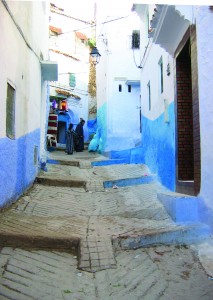
I’ve been on countless adventures in the course of my life, but nothing as foreign as Morocco or so close to the markers of history. I journeyed there to determine if this quest is worth the investment of time and money. Over the course of 13 days we traveled roughly 2,760 kilometers, or 1,725 miles—only about 50 miles were on roads wider than two lanes, and many were on single-lane. Judge for yourself if it’s your glass of (Moroccan) mint tea.
DAY ONE
Chano Lorenzo, IMT guide extraordinaire, and Scott are at the Seville airport as promised. This is a good start, as I’ve just been on airline seats for more than 14 hours in positions that would give a yogi claustrophobic tremors. The Iberian Moto Tours sign held high is a welcome sight. Scott appears much younger then I’d imagined (he’s 39 but could pull off 29 without question) and has me with his first question—“You ready for a beer?”
The Plaza De Armas is a five-star hotel, and best of all, only a 20-minute drive from the airport. I meet Isabelle Brochet, Scott’s girlfriend, along for a little R&R of her own. After easy conversation over snacks, my mind is eased some—I like these guys a bunch. Scott and Chano’s knowledgeable, can-do attitudes exude confidence, and Isabelle is just plain charming.
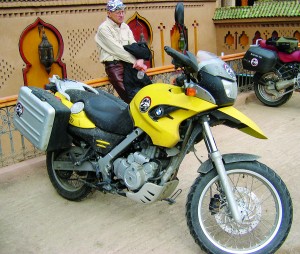
DAY TWO
Arriving a day early gives me time to talk with Scott before the other riders get in. The extra day also gives me time to walk around Seville in the morning. After lunch I assist Scott and Chano in riding spotless BMWs from the dealer to the underground parking at the hotel. Scott tosses me a key and says, “Hold on to it, that’s yours for the next two weeks.” I get my first ride on a BMW R1150GS. Traffic in general is about the same as any major European city, but scooters and motorcycles avigate at a considerably more aggressive pace here. The good news—cars and trucks make room and respect two wheels. Nice!
That evening in the lobby we are all together as a group for the first time. Introductions are made and the eye-darting and sizing-up of fellow riders continues throughout the briefing. We receive a once-over on the information we should have already read in the booklet, both in Spanish and English. Scott is thorough. The first thing that hits me is that there could be a communication issue down the road. Among those not part of IMT, four are from Chile, one from Argentina, one Spain and three the United States.
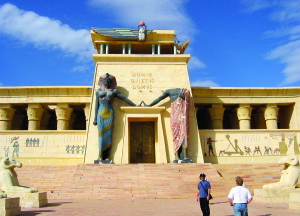
Final instructions are, luggage and riders in the lobby at 8:30 a.m., clutches out at 9.
DAY THREE
Today was billed as an easy ride to get comfortable with your motorcycle. We stop after the first hour to check for concerns. The bikes are to everyone’s liking. We’ve been riding a two-lane, olive treelined highway, idyllic, with only slight undulations and the occasional picturesque dwelling. From here, Scott warns us that the road narrows and the curves will come more frequently. An understatement understatement on both accounts, we soon discover. The road is twisty, wide enough for only a single car in most places, with gravel spilling over both shoulders. So captivating, though, were the roads, the landscape, the moment, instead of rolling carefully, some dialed it up. From my perspective, only Scott was familiar enough with the roads this early to have gone that hard. We ride through light drizzle on the way to the Mediterranean port town of Algeciras, ending the day at the Hotel Reina Christina.
DAY FOUR
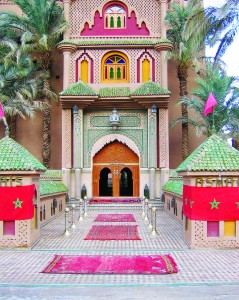
We roll at 8:30 this morning. Mustn’t miss the ferry across the Strait of Gibraltar to Africa, otherwise the entire day’s schedule would be ruined. Once aboard and stowed away, 45 minutes later we are ashore in the Spanish enclave of North Africa, just a few klicks from the Moroccan border. Our destination today is Chefchaouen, high in the Rif Mountains. This area is infamous for peddlers jumping in front of vehicles holding baseball-sized wads of hashish. The road is excellent, winding pleasantly, the weather accommodatingly sunny—there are no issues today. The dramatic border crossing into Morocco has us all humbly and overwhelmingly accepting the journey. Two of the Chileans, Sandro and Fernando, I’ve discovered, speak German. We have a common language, improving communication and enjoyment several notches.
DAYS FIVE-EIGHT
The ride to Fez is relatively short, 292 kilometers, with mountain sweepers, farmland, olive trees and bumpy sections. We have time to visit Volubilis, Roman ruins dating back to the second century A.D. Our guide for Fez, Mohib, meets us at a gas station on the outskirts. It’s our first taste of Morocco city traffic, clearly the most treacherous part of the tour. Not only Fez—all the Moroccan cities. Traffic here can best be described as controlled chaos without an EPA.
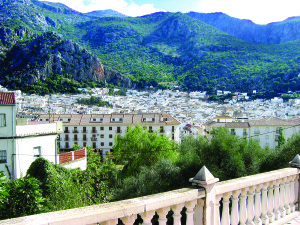
Day six is our first rest day. Mohib takes us deep into the mazelike Medina, the oldest marketplace in Morocco dating back to the eighth century. Anything can be found here—anything! Mohib explains that people living here still equate sleeping each night with death. In the morning they are grateful that all begins anew.
Day seven has us riding 433 kilometers to the Sahara Desert town of Erfoud over long, empty desert roads. I take advantage of no enforceable speed limit and exercise the GS. After lunch we encounter a first for everyone—locusts, clouds of them—tough little buggers crashing into everything. This continues on and off for 60 klicks or more.
Day eight is our second rest day and includes a 4×4 tour to the Shifting Sand Dunes with guides Hassan and Mohamed. Intermittent thunder and rain all day rewards us with a spectacular double rainbow over the Sahara near dusk.
DAYS NINE-TWELVE
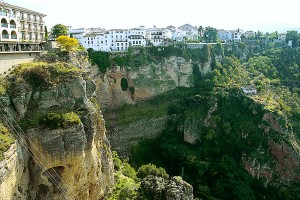
The ride to Zagora is 316 kilometers and includes our southernmost point. The road is mostly straight desert; intermittent sweepers keep us awake into Valley de Draa. I have time to reflect on the extreme poverty all around, yet I’ve witnessed more smiles and dignity here then on the streets of my hometown. We riders, although from different countries and backgrounds, have bonded—we watch each other’s backs. Scott’s gregariousness is to thank in large part for keeping it so. Each of us has hit and passed through our own personal walls, a consequence of acute travel focus. In these tight quarters, a pissy attitude would be quickly magnified to an annoying magnitude. Thankfully, no one goes there.
This is traditionally one of the driest stretches of road, but flash flooding presents us with a chocolate-hued water crossing. Chano and Scott’s relationship continues to be infectious; they openly respect and enjoy working together, and this benefits all. Chano has been the perfect roommate during the expedition. Can’t dislike a guy who wakes each morning whistling. At today’s first stop, though, I tell him that he led the group too fast, through towns with pedestrians on both sides and no sidewalks. I explain how that doesn’t fly back home. He accepts my opinion with a smile.
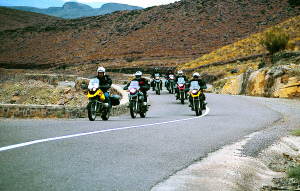
Perhaps my favorite day is 11, over the snow-dusted High Atlas Mountains. The scenery, sunshine, motorcycle and banked sweepers are all in perfect rhythm—even Marrakech can’t ruin today.
Marrakech has far too much tourism awareness. The business is people and business is slow—the result is up-in-your-grille aggressiveness by everyone, asking for payola for everything, even for taking a picture of a snake charmer. I just want to get through rest day 12 and ride tomorrow.
CONCLUSIONS
Rabat is our last Moroccan night. It’s the capital and the most westernized of all the big cities, with heavy traffic, but far more orderly.
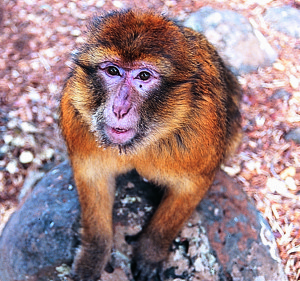
Our last night in Africa is in the Spanish town of Sebta. From here out, the riding is more of the same, and with each kilometer we’re closer to home. Our last lunch together is in the brilliant city of Ronda, carved onto a 400-foot cliff overlooking a pastoral valley. It’s easy to understand why Hemingway felt inspired here. The only blemish on the day is Ruth crashing on a steep driveway decent, spilling gas on herself and breaking an ankle. To her credit, she completed the ride.
During the past two weeks there were occasions when things got annoyingly unsafe, riders repeatedly displayed a lack of group-riding experience, when things could have gone horribly wrong—but they didn’t. There were times when more rest and less shopping would have been in order. There were interaction snafus. Yet all is overshadowed, and forgiven, by the sheer dynamic motorcycling adventure. To a rider, all agreed they were quite happy that they had come. Would I do it again? Give me some time to rest and think on it.
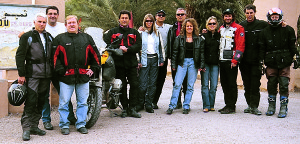
Perhaps it’s because of the intense alertness that’s required, so many things to remember—passport, bike key, wallet, gloves—or the clinging to things I never want to forget. Maybe it was the daily adrenaline and total concentration on the road, the surroundings, the tight bonds of camaraderie formed with the other riders, but something was different with me when I returned home. Ever so slightly, but definitely altered. For a few days I found myself out of sync with friends and family, like the dialog and moving lips in a martial-arts movie. I clung desperately to this new, broader,
wiser-minded me for as long as I could. One more day on the roads of Morocco should be all right. Just one more day before real life calls me back.
IMT Morocco Essentials
The individual price of an Iberian Moto Tour is dependent on single or double room occupancy and choice of mounts. Almost all BMW models are offered, and motorcycle damage insurance is offered with a $300 deductible. Two riders on this tour dropped their bikes and one lost a side case when he didn’t secure it properly. Both went over the deductible and both were happy to have purchased the insurance.
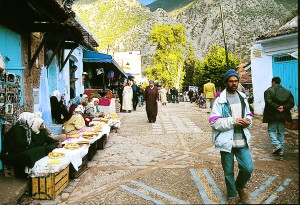
Depending on your Morocco tour flight schedule, you’ll be gone 14-15 days. Don’t overpack, but think it through. There’s lots of room in the support van. Include plenty of layers; conditions can change hourly, and don’t forget raingear—it rains even in the Sahara. Don’t forget sunglasses and sunscreen. You’re out in the elements for many hours a day.
Be prepared to spend about $18 a day on gasoline and around $15 on lunch each day. Dinners and breakfast are all covered (except for dinner on the three rest days). Bring something for settling your stomach and diarrhea. The change of diet affects everyone differently. Also prepare for shopping aplenty. At most stops the locals rely heavily on the tourist dollar. You will, at some point, feel inclined to make purchases. Carpet shops (some of the finest in the world) and most other shops will ship things home, often included in the purchase price. ATMs are accessible in almost every city.
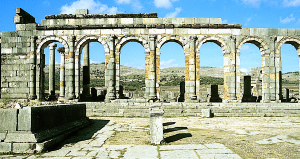
While in Morocco, you will be served the perquisite glass of mint tea at every shop and restaurant. This is a concoction of fresh mint leaves stuffed into a glass with hot sugar water poured on top, and always from about 18 inches above the glass. It’s a very sweet drink, and to be consumed correctly, it should be finished in no more than five slurping gulps.
Lastly, come to this journey fit. Not necessarily triathlon fit, but be prepared to walk and climb stairs some. The healthier and more open-minded you arrive, the more rewarding an experience will unfold for you. There are three scheduled Morocco tours each year. Check IMT’s Web site at www.imtbike.com for dates or contact Iberian Moto Tours, Armonk Travel, 145 Bedford Road, Suite 102, Armonk, New York 10504; (800) 255-7451.
(This article was published in the March 2005 issue of Rider.)

